|
|
AGRA
 At the time of the Mughals, in the
16th and 17th centuries, Agra was the capital of India, and its superb
monuments date from that era. Agra has a magnificent fort and the
building, which many people come to India solely to see- the Taj Mahal. At the time of the Mughals, in the
16th and 17th centuries, Agra was the capital of India, and its superb
monuments date from that era. Agra has a magnificent fort and the
building, which many people come to India solely to see- the Taj Mahal.
Situated on the banks of the Yamuna River, Agra, with its crowded
alleys and predatory rickshaw riders, is much like any other north
Indian city, once you're away from its imposing Mughal monuments. It's
possible to take a day trip to Agra from Delhi however; Agra is
worth more than a day's visit, particularly if you intend to visit, as
you certainly should, the deserted city of Fatehpur Sikri. In any
case, the Taj certainly deserves more than just a single visit if you
want to appreciate how its appearance changes under different lights.
TAJMAHAL
The TAJ MAHAL,
one of the Seven Wonders of the World, reminds us of the love story like no
other. This
most famous Mughal monuments was constructed by Emperor Shah Jahan in
memory of his wife Mumtaz Mahal, chosen of the Palace. It has been
described, as the most extravagant monument ever built for love for
the emperor was heartbroken when Mumtaz, to whom he had been married
for 17 years, died in 1631 in childbirth, after producing 14 children.
Construction
of the Taj began in the same year and was not completed until
1653.Workers were recruited not only from all over India but also from
 central Asia, and in total 20,000 people worked on the building.
Experts were even brought from as far away as Europe – the Frenchman
Austin of Bordeaux and the Italian Veroneo of Venice had a hand in its
decoration. The main architect was Isa Khan, who comes from Shiraz in
Iran. central Asia, and in total 20,000 people worked on the building.
Experts were even brought from as far away as Europe – the Frenchman
Austin of Bordeaux and the Italian Veroneo of Venice had a hand in its
decoration. The main architect was Isa Khan, who comes from Shiraz in
Iran.
The most unusual (but
almost certainly apocryphal) story about the Taj is that there might
well have been two of them. Shah Jahan, it is said, intended to build
a second Taj as his own tomb in black marble, a negative image of the
white Taj of Mumtaz Mahal. Before he could embark on this second
masterpiece he was deposed by his son, Aurangzeb. Shah Jahan spent the
rest of his life imprisoned in the Agra Fort, looking out along the
river to the final resting place of his wife.
The Taj is definitely
worth more than a single visit as its character changes with the
differing lights during the day.
Dawn is a magical time, and it’s virtually deserted. Fridays
tend to be impossibly crowded and noisy- not very conducive to calm
enjoyment of this most serene of buildings.
The high red sandstone entrance gateway is inscribed with
verses from the Koran in Arabic, but these days you only exit through
here. The entrance is now through a small door to the right of the
gate, where everyone has to undergo a security check.
Paths leading from the gate to the Taj are divided by a long
watercourse in which the Taj is beautifully reflected. The ornamental
gardens through which the paths leads are set out along the
classical Mughal charbagh lines- a square the flowerbeds by the paths
are a profusion of colour. To the west is a small museum housing
original architectural drawings of the Taj, arms, miniatures and some
examples of celadon plates, said to split into pieces or change colour
if the food served on them contained poison.
The Taj Mahal itself stands on a raised marble platform
on the northern edge of the ornamental gardens. Tall, purely decorated
white minarets grace each corner of the platform-as the Taj Mahal is
not a mosque, nobody is called to prayer from them. Twin red sandstone
buildings frame the building when viewed from the river; the identical
one on the east side is purely for symmetry. It cannot be used as a
mosque as it faces the wrong direction.
The central Taj structure has four small domes
surrounding the huge, bulbous, central dome. The tombs of Mumtaz Mahal
and Shah Jahan are in a basement room. Above them in the main chamber
are false tombs, a common practice in mausoleums of this type. Light
is admitted into the central chamber by finely cut marble screens. The
echo in this high chamber, under the soaring marble dome, is superb
and there is always somebody there to demonstrate it.
Although the Taj is amazingly graceful from almost any angle,
it's the close-up detail which is really astounding. Semiprecious
stones are inlaid into the marble in beautiful patterns and with
superb crafts in a process known as pietra dura. The precision and
care which went into the Taj Mahal's design and construction is just
as impressive whether you view it from across the river or from arm's
length. Overnight stay in the Hotel.
AGRA FORT
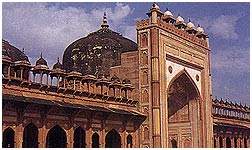 Construction of the massive Agra Fort was begun by Emperor Akbar in
1565, and additions were made up until the time of his grandson, Shah
Jahan. While in Akbar’s time the fort was principally a military
structure, by Shah Jahan’s time it had become partially a palace. A
visit to the fort is an Agra ‘must’ since so many of the events
which led to the construction of the Taj took place here. Construction of the massive Agra Fort was begun by Emperor Akbar in
1565, and additions were made up until the time of his grandson, Shah
Jahan. While in Akbar’s time the fort was principally a military
structure, by Shah Jahan’s time it had become partially a palace. A
visit to the fort is an Agra ‘must’ since so many of the events
which led to the construction of the Taj took place here.
There are many fascinating buildings
within the massive walls, which stretch for 2.5 km, surrounded by a
moat over 10 metres wide. Inside the fort is really a city within a
city. Not all of the buildings are open to visitors, and Shah
Jahan’s beautiful marble Moti Masjid (known as the Pearl Mosque for
its perfect proporations) is, unfortunately, closed.
The fort is on the banks of the Yamuna
River and the Amar Singh Gate to the south is the only entry point.
Diwan-i-am:
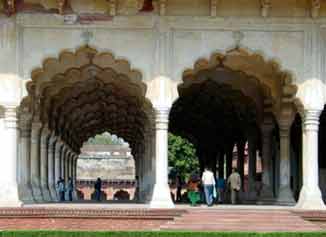 The Hall of Public Audiences was also built by Shah Jahan and replaced
an earlier wooden structure. Shah Jahan's predecessors had a hand in
the hall's construction, but the throne room, with its typical inlaid
marble work, indisputably bears Shah Jahan's influence. Here be sat to
meet officials or listen to petitioners. Beside the Diwan-i-am is the
small Nagina Masjid or Gem Mosque and the Ladies' Bazaar where
merchants came to display and sell goods to the ladies of the Mughal
Court. The Hall of Public Audiences was also built by Shah Jahan and replaced
an earlier wooden structure. Shah Jahan's predecessors had a hand in
the hall's construction, but the throne room, with its typical inlaid
marble work, indisputably bears Shah Jahan's influence. Here be sat to
meet officials or listen to petitioners. Beside the Diwan-i-am is the
small Nagina Masjid or Gem Mosque and the Ladies' Bazaar where
merchants came to display and sell goods to the ladies of the Mughal
Court.
Diwan-i-Khas:
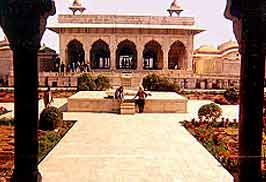 The Hall of
Private Audiences was also built by Shah Jahen between 1636 and 1637.
Here the emperor would meet important dignitaries or foreign
ambassadors. The hall consists of two rooms connected by three arches.
The famous Peacock Throne was kept before being moved to Delhi by
Aurangzeb. It was later carted off to Iran and its remain are now in
Tehran. The Hall of
Private Audiences was also built by Shah Jahen between 1636 and 1637.
Here the emperor would meet important dignitaries or foreign
ambassadors. The hall consists of two rooms connected by three arches.
The famous Peacock Throne was kept before being moved to Delhi by
Aurangzeb. It was later carted off to Iran and its remain are now in
Tehran.
Octagonal Tower:
 The
Musamman Burj, or Octagonal Tower, stands close to the Diwan-i--Khas
and the small, private Mina Masjid. Also known as the Saman Burj, this
tower was built by Shah Jahan for Mumtaz Mahal and is another of his
finely designed buildings. It was here, with its views along the
Yamuna to the Taj, that Shah Jahan died in 1666, after seven years'
imprisonment. Unfortunately the tower has been much damaged over the
years.
The
Musamman Burj, or Octagonal Tower, stands close to the Diwan-i--Khas
and the small, private Mina Masjid. Also known as the Saman Burj, this
tower was built by Shah Jahan for Mumtaz Mahal and is another of his
finely designed buildings. It was here, with its views along the
Yamuna to the Taj, that Shah Jahan died in 1666, after seven years'
imprisonment. Unfortunately the tower has been much damaged over the
years.
Jehangir's Palace:
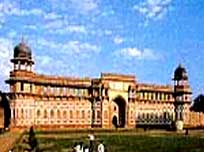 Akbar is believed to have built this palace, the largest private
residence in the fort, for his son. This was one of the first
constructions demonstrating the fort's changing emphasis from military
to luxurious living quarters. The palace is also interesting for its
blend of Hindu and central Asian architectural styles- a
contrast to the unique Mughal style which had developed by the time of
Shah Jahan.
Akbar is believed to have built this palace, the largest private
residence in the fort, for his son. This was one of the first
constructions demonstrating the fort's changing emphasis from military
to luxurious living quarters. The palace is also interesting for its
blend of Hindu and central Asian architectural styles- a
contrast to the unique Mughal style which had developed by the time of
Shah Jahan.
Other
Buildings Shah Jahan's Khas
Mahal is a beautiful white marble structure used as a private palace.
The rooms underneath it were intended as a cool retreat from the
summer heat. The Shish Mahal or Mirror Palace is reputed to have been
the harem dressing room and its walls are inlaid with tiny mirrors.
The Anguri Bagh or Grape Garden probably never had any grapevines but
was simply a small, formal Mughal garden. It stood in front of the
Khas Mahal. The Delhi Gate and Hathi Pol, or Elephant Gate, are now
closed.
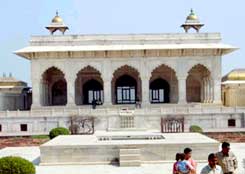 In front of the
Jehangir Palace is the Hauz-i-Jehangri, a huge 'bath' carved out of a
single block of stone- by whom and for what purpose is a subject of
conjecture. The Amar Singh Gate takes its name from a Maharaja of
Jodhpur who was killed beside the gate, along with his followers,
after a brawl in the Diwan-i-Am in 1644! Justice tended to be summary
in those days; there is a shaft leading down to the river into which
those who made themselves unpopular with the great Mughals could be
hurled without further ado. In front of the
Jehangir Palace is the Hauz-i-Jehangri, a huge 'bath' carved out of a
single block of stone- by whom and for what purpose is a subject of
conjecture. The Amar Singh Gate takes its name from a Maharaja of
Jodhpur who was killed beside the gate, along with his followers,
after a brawl in the Diwan-i-Am in 1644! Justice tended to be summary
in those days; there is a shaft leading down to the river into which
those who made themselves unpopular with the great Mughals could be
hurled without further ado.
Jama
Masjid:
Across the railway tracks from the Delhi Gate of Agra Fort, the Jama
Masjid was built by Shah Jahan in 1648. An inscription over the main
gate indicates that it was built in the name of Jahanara, Shah Jahan's
daughter, who was imprisoned with Shah Jahan by Aurangzeb. Large
though it is, the mosque is not as impressive as Shah Jahan's Jama
Masjid in Delhi
Itimad-ud-
daulah
The first place of interest is the
exquisite Itimad-ud-daulah- the tomb of Mirza Ghiyas Beg. This Perisan
gentleman was Jehangir's wazir, or chief minister, and his beautiful
daughter later married the emperor. She then became known as Nur Jahan,
the Light of the World, and her niece was Mumtaz Mahal, Chosen of the
Palace. The tomb was constructed by Nur Jahan between 1622 and 1628
and is very similar to the tomb she constructed for her husband,
Jehangir, near Lahore in Pakistan.
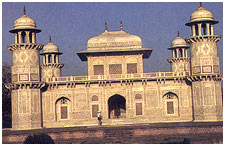 The tomb is of particular interest since many of its design
elements foreshadow the Taj, construction of which started only a few
years later. The Itimad-ud-daulah was the first Mughal structure
totally built from marble and the first to make extensive use of
pietra dura, the inlay work of marble, which is so characteristic of
the Taj. The mausoleum is small and squat compared to the soaring Taj,
but the smaller, more human scale somehow makes it attractive, and the
beautifully patterned surface of the tomb is superb. Extremely fine
marble latticework passages admit light to the interior. It's well
worth a visit.
The tomb is of particular interest since many of its design
elements foreshadow the Taj, construction of which started only a few
years later. The Itimad-ud-daulah was the first Mughal structure
totally built from marble and the first to make extensive use of
pietra dura, the inlay work of marble, which is so characteristic of
the Taj. The mausoleum is small and squat compared to the soaring Taj,
but the smaller, more human scale somehow makes it attractive, and the
beautifully patterned surface of the tomb is superb. Extremely fine
marble latticework passages admit light to the interior. It's well
worth a visit.
Chini Ka
Rauza:
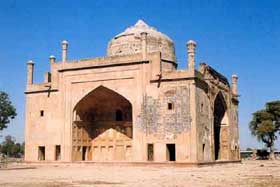 The China Tomb is one km north of the Itimad-ud-daulah. The squat,
square tomb, surmounted by a single huge dome, was constructed by
Afzal Khan, who died at Lahore in 1639. He was a high official in the
court of Shah Jahan. The exterior was covered in brightly coloured
enamelled tiles and the whole building clearly displayed its Persian
influence. Today it is much decayed and neglected, and the remaining
tile work only hints at the building's former glory.
The China Tomb is one km north of the Itimad-ud-daulah. The squat,
square tomb, surmounted by a single huge dome, was constructed by
Afzal Khan, who died at Lahore in 1639. He was a high official in the
court of Shah Jahan. The exterior was covered in brightly coloured
enamelled tiles and the whole building clearly displayed its Persian
influence. Today it is much decayed and neglected, and the remaining
tile work only hints at the building's former glory.
Ram Bagh:
Laid out in 1528 by Babur, first of the Mughal emperors, this is the
earliest Mughal garden. It is said that Babur was temporarily
buried here before being permanently interred at Kabul in
Afghanistan. The Ram Bagh is two km north of the Chini Ka Rauza on the
riverside and is open from sunrise to sunset;.
Dayal Bagh Temple:
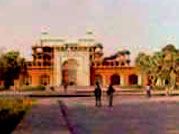 In Dayal
Bagh, the white marble samadhi (or temple) of the Radah Soami religion
is currently under construction. It was started in 1904 and is not
expected to be completed until sometime next century. You can see
pietra dura inlaid marblework actually being worked on. Although the
building is architecturally nothing remarkably (some would go so far
as to call it gaudy, disproportioned and somewhat ugly), the level of
artisanship has to be admired In Dayal
Bagh, the white marble samadhi (or temple) of the Radah Soami religion
is currently under construction. It was started in 1904 and is not
expected to be completed until sometime next century. You can see
pietra dura inlaid marblework actually being worked on. Although the
building is architecturally nothing remarkably (some would go so far
as to call it gaudy, disproportioned and somewhat ugly), the level of
artisanship has to be admired
Other
Attractions
The Kinari Bazaar, or old
marketplace, is a fascinating area to wander around. It's in the old
part of Agra, near the fort, and the narrow alleys of the market start
near the Jama Masjid. There are several market areas, or mandis, in Agra
with names left over from the Mughal days, although they bear no
relation to what is sold there today. The Loha Mandi (Iron Market) and
Sabji Mandi (Vegetable Market) are still used, but the Nai Ki Mandi
(Barber's Market) is now famous for textiles. In the Malka Bazaar
women beckon to passing men from the upstairs balconies.
Is situated in the center
of the town, on the banks of the River Yamuna. Various styles of
architecture are evident within the fort and demonstrate the boldness
of Akbar's period, the refinement of Jehangir's times, and the
subtleness of Shah Jahan's rule. Overnight stay in the Hotel
Shopping:
Agra
is well known for leather goods, jewellery, dhurrie (rug)
weaving and marble items inlaid with coloured stones, similar to the
pietra dura work on the Taj. Sadar Bazaar and the area south of Taj
Ganj are full of emporiums of one kind or another, but prices here are
more expensive than in the bazaars of the old part of the city. The
best jewellery shops are around Pratapur, also in the old part of
Agra, though you can still pick up precious stones cheaper in Jaipur.
About a kilometer along the road running from the
eastern gate of the Taj is Shilpgram, a crafts village and
open-air-emporium. It has displays of crafts form all over the
country.
enroute visit small villages on reaching you first visit the
Sikandra Fort, later check in to a hotel .Over night stay in the
hotel.
SIKANDRA
TOMB:
Akbar Mausoleum: At Sikandra, 10 km north-west of Agra, the tomb of
Akbar lies in the centre of a large peaceful garden. Akbar started its
construction himself but it was completed by his son, Jehangir, who
significantly modified the original plans, which accounts for the some
-what cluttered architectural lines of the tomb.
 The building has three-storey minarets at each corner and is
built of red sandstone inlaid with white marble polygonal patterns.
Four red sandstone gates lead to the tomb complex: one is Muslim, one
Hindu, one Christian, and one is Akbar's patent mixture. Like
Humayun's Tomb in Delhi, it is an interesting place to study the
gradual evolution in design that culminated in the Taj Mahal. Akbar's
mausoleum is open from sunrise and sunset. The building has three-storey minarets at each corner and is
built of red sandstone inlaid with white marble polygonal patterns.
Four red sandstone gates lead to the tomb complex: one is Muslim, one
Hindu, one Christian, and one is Akbar's patent mixture. Like
Humayun's Tomb in Delhi, it is an interesting place to study the
gradual evolution in design that culminated in the Taj Mahal. Akbar's
mausoleum is open from sunrise and sunset.
Sikandra is named after Sultan Sikandar
Lodhi, the Delhi ruler who held power from 1488 to 1517, immediately
preceding the rise of Mughal power on the subcontinent. The Baradi
Palace, in the mausoleum gardens, was built by Sikandar Lodhi. Across
the road from the mausoleum is the Delhi Gate. Between Sikandra and
Agra are several tombs and two Kos minars, or milestones. |





